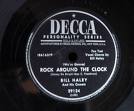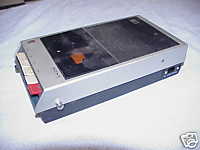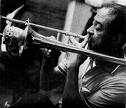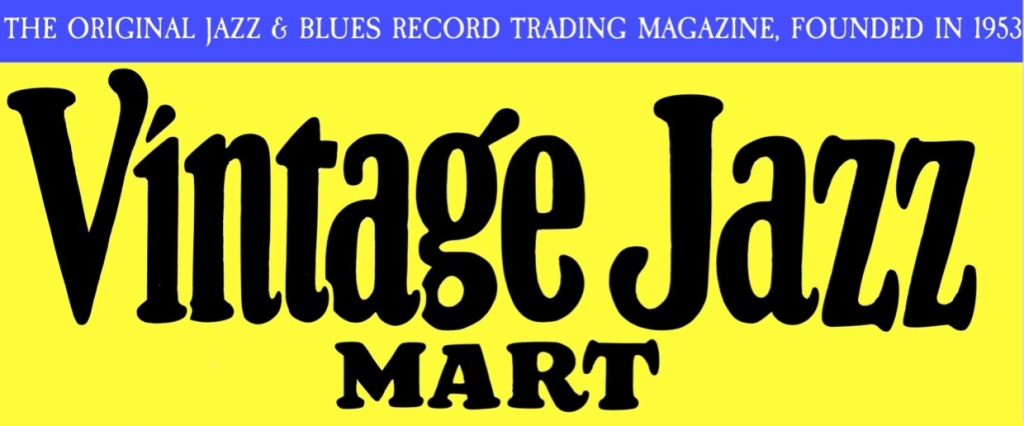If the phonograph record had never been invented, jazz might have remained a local art form heard only on a visit to New Orleans. Charlie Parker might well be only a remote name, an unheard legend to listeners born after 1955.
Phonograph records are objects that make music accessible and permanent, and I grew up surrounded by them. My father, a motion picture projectionist, was also expected to be an unpaid disc jockey, someone who would fill the theatre with music between shows by spinning records from the projection booth. I remember his story of the first explosion of rock ‘n’ roll. During an intermission, he reached for a record whose title meant nothing to him, put it on with the volume turned off in the booth, and turned back to his book. Then the theatre manger called him in a near-frenzy, “Take that God-damned record off! The kids are dancing on the seats and ripping up the theatre!”
 It was the famous (or infamous) record here.
It was the famous (or infamous) record here.
As 78 rpm records gave way to microgroove, my father would occasionally bring an outmoded record home rather than see it thrown away. He was intrigued by technology, and we had a Revere reel-to-reel tape recorder, which I learned how to use early on.
Later, around 1968, he brought home something new, a portable cassette recorder and a few blank tapes.
By this time, I had become converted to jazz, which I thought of as my music. It as a secret pleasure: I thought of myself as a subversive, listening to Louis while everyone around me was deeply absorbed by rock. In my suburban hermitage, I recorded jazz radio shows — John S. Wilson’s “World of Jazz,” Ed Beach’s “Just Jazz,” and made them my soundtrack. Records were not easy to get and I couldn’t afford all that I wanted, so the idea of tape-recording a precious performance and listening to it over and over shaped my first experiences of the music. I lived for the moment when everything seemed cosmically aligned: Beach would be playing two hours of rare Jo Jones records on WRVR-FM; I would be home at the right time with a reel of blank tape; I could listen to it while the show was being broadcast; I would tape it to hear it again. It would become mine. In my memory, I can see those tape boxes, each one holding a precious hour or two of Buck Clayton, of 1940 Ellington, or Lee Wiley.
I grew up on Long Island, an environment defined by the distance from one shopping mall to the next, and I recognize its inherent provincialism. But for someone like myself, entranced by jazz, being born there rather than in Cape Breton was great good fortune. In The New Yorker, I could read the names of musicians I had heard on radio or records. They were playing live in New York City, an hour away by train and subway or car.
I do not remember the details of the first live jazz I heard in Manhattan. Was it in Town Hall or the Half Note? But I prepared for this precious experience by bringing my cassette recorder with me. It seemed logical rather than perverse to be a jazz anthropologist, a swing explorer. Vasco DaGama of Dixieland, if you will. I could poke my nose beyond my comfortable suburban environment, venture into the uncharted City, capture a performance live and return home with the reward. Not gold or pepper or notes on the marriage rituals in New Guinea, but a homemade recording, however flawed, of the music I had heard last night. A prize — to revisit, to study, to treasure.
Of course the idea wasn’t new. Jazz enthusiasts had been capturing the music in its native habitat since the Thirties, perhaps earlier. I had read about airshots, “on location” acetates, and live recordings, essential parts of jazz’s mythology. That these recordings had often been made secretly by amateurs happily breaking the rules was even better. Their illicit behavior was evidence of deep devotion to the art. They wanted to keep what they had heard once from vanishing forever. Even though I didn’t think about the implications of what I wanted to do, I now think there was a touch of late-Sixties political rebellion implicit in it. Why should the recording companies control the music, and why should I be deprived of doing so? When I had seen Louis Armstrong and his All-Stars in 1967, I had been too naive to bring my Instamatic camera to take twelve snapshots. Now Louis was dead, and I had only an autograph and my memory of what he had looked like, what he had played.
I was not sufficiently prideful or self-deluded to think of myself as the Long Island reincarnation of Jerry Newman at Minton’s or Dean Benedetti in search of Bird. But perhaps I could capture a memorable chorus or ensemble, even in low-fidelity. Would it become valuable over time? What did that matter? It would be precious now.
This may strike some readers as more peculiar than collecting stamps or baseball cards. Some jazz-lovers may be satisfied to hear a beautiful performance once, never again. But this art is so splendidly evanescent that the thought of it going away is nearly painful. It cries out to be preserved. In terms of jazz’s brief chronological history, I am a late-comer. Many of the great players were dead by the late Sixties; many of their portraits greeted me when I turned to the obituary page of The New York Times: I saved those clippings until the sheaf got too depressing. It felt as if all the creators were leaving town, and this may have goaded me into illicit tape-recording as a way of snaring what moments I could before it was too late.
I would never see PeeWee Russell or Red Allen, Coleman Hawkins or Rex Stewart . . . but when Benny Morton or Jimmy Rushing played a gig, I would not let their sounds escape me.
 Thus my life of crime began. Being a criminal is difficult, let me tell you.
Thus my life of crime began. Being a criminal is difficult, let me tell you.
Many club-owners did not care about a couple of college kids with their cassette recorder, sitting as close to the bandstand as possible, as long as the kids bought beer or hamburgers at regular intervals, but some establishments were very serious about such infractions. I nearly got thrown out of the Village Vanguard a few years ago when the waiter noticed something glittering in my lap – a minidisc recorder, its display a bright phosphorescent blue. He said that I could stop recording right now or I would have to leave, in tones that suggested New York’s finest were pounding down Seventh Avenue South in hot pursuit of Another Jazz Miscreant.
And it was even worse in larger places, with notices hanging everywhere that The Taking Of Photographs and The Use Of Recording Devices Is Prohibited By Law. But I had seen that the ushers were not athletic enough to arrest everyone with a tiny Kodak (flashbulbs went off at many performances) so I thought that I might get away with my criminalities. I became sly, sidling into a concert hall with a blue plastic shoulder bag, trying to look nonchalant, always a failed enterprise. The bag held a newspaper or magazine – a thin subterfuge – covering my cassette recorder, a $60 Shure microphone, and extra batteries. Illegal and delicious. I evaded what I thought were the peering eyes of the usher, usually someone who wanted only to give me a program and seat me in the right place, then scuttle away. In the semi-darkness, while people talked, rattled their programs, unwrapped their cough drops, I would connect the microphone to the recorder and drop the heavy wire down through the sleeve of my jacket so that the microphone could be hidden in my lap. I knew that my applause –the sound of two hands clapping — would be deafening on the tape, so I learned to look enthusiastic while pretending to clap.
Emboldened by success, I brought a tape recorder to nearly every jazz performance I could. Sometimes those tapes, heard the next day, were mediocre: routine music, badly recorded, turns out to be not worth the effort. Occasionally, there were what college radio stations call “technical difficulties” and I had recorded nothing. In those cases, crime certainly did not pay. But I captured hours and hours of jazz that gave me pleasure. Even the roll call of the players delights me now: just to think of pianists, I come up with Earl Hines, Eubie Blake, Dick Wellstood, Art Hodes, Joe Bushkin, Dave McKenna, Jimmy Andrews, Count Basie, Mark Shane, Teddy Wilson, Dick Hyman, Bill Evans, Jimmy Rowles, Ralph Sutton, Dill Jones, Hank Jones, Claude Hopkins, Chuck Folds, Don Friedman, Red Richards, Ellis Larkins, and two dozen others.
Concert halls were usually terrible places for surreptitious recording because they were often terrible places to hear music. The sound technicians at Carnegie Hall, for instance, where many of the Newport-New York concerts were held, apparently took perverse pleasure in making the piano sound as much unlike itself as possible. The eye saw Teddy Wilson seated at a Steinway: the ear heard metal striking metal. And you can imagine the acoustics at the top of Radio City Music Hall. At the first of the 1972 jam sessions, Stu Zimny and I were seated in what seemed the upper reaches of the earth, next to a pair of Texas women who whooped happily when Gene Krupa hit his splash cymbal or when Roy Eldridge went for a high note. Before the concert and during it, they most cordially offered us whiskey from bottles they had hidden in their pocketbooks; not to be outdone in gallantry, I offered them chocolate. Both of us stuck to the stimulants we knew best. But I cannot complain. When I hear those tapes again, their exuberant hollering is part of the experience of the music, of having been there.
Small clubs were easier to record in, and there was a better chance to be forgiven my wickedness, especially if I had spoken to the musicians beforehand and gotten their permission. Since I looked at my jazz heroes with reverence, this approach often worked. Kenny Davern, who had a powerful prejudice against playing into a microphone, showed me how to set mine so that it would record effectively. Ruby Braff got so used to me and my friends that he dubbed us “Tapes,” as in, “Hey, Tapes!” when he saw us.
 One Sunday in 1972, Bobby Hackett, a gracious man, looked down at my brand-new Teac reel-to-reel recorder, perhaps forty pounds, that I had lugged into Your Father’s Mustache in hopes of recording him. I was sweating already, and his noticing the machine made me even more moist, from anxiety. What if he growled, “What the hell do you think you’re doing?” But all he said was, mildly, “What brand is that?” And when I told him, he smiled and said, “I have one like it at home,” and went about the business of getting ready for the gig.
One Sunday in 1972, Bobby Hackett, a gracious man, looked down at my brand-new Teac reel-to-reel recorder, perhaps forty pounds, that I had lugged into Your Father’s Mustache in hopes of recording him. I was sweating already, and his noticing the machine made me even more moist, from anxiety. What if he growled, “What the hell do you think you’re doing?” But all he said was, mildly, “What brand is that?” And when I told him, he smiled and said, “I have one like it at home,” and went about the business of getting ready for the gig.
But my criminality wasn’t always well-received. The trumpeter Joe Thomas fretted about our taping him at an outdoor concert in Battery Park. He was insistent that that “the union man” would find us out and that he would get in trouble. I don’t remember how we soothed his fears (did we hide the recorder in a flowerbed?) but it took a good deal of placating before he let us go ahead.
Some musicians were unwilling to be taped, and, in retrospect, I can’t blame them. Perhaps someone unscrupulous had taken advantage in the past. The pianist Cyril Haynes refused to play a note until I put my recorder away.
 I can see in my mind’s eye the brilliantly eccentric trombonist Dicky Wells, at the back of the bandstand clogged with other musicians, shaking his head from side to side in vehement “No-no-no!” and waving his arm and outstretched index finger in energetic arcs. I remember a session featuring cornetist Wild Bill Davison, where I set up my microphone right under the bell of his horn. He asked, gruffly, “Are you planning to record me with that?” “Yes, Mr. Davison,” I politely replied. “Well, that will cost you one Scotch now and one for each set you record,” he said in what seems now to have been a well-rehearsed speech. I considered my budget for a moment and put the recorder back in the bag. Was he disappointed at the failure of his bargain? I couldn’t tell.
I can see in my mind’s eye the brilliantly eccentric trombonist Dicky Wells, at the back of the bandstand clogged with other musicians, shaking his head from side to side in vehement “No-no-no!” and waving his arm and outstretched index finger in energetic arcs. I remember a session featuring cornetist Wild Bill Davison, where I set up my microphone right under the bell of his horn. He asked, gruffly, “Are you planning to record me with that?” “Yes, Mr. Davison,” I politely replied. “Well, that will cost you one Scotch now and one for each set you record,” he said in what seems now to have been a well-rehearsed speech. I considered my budget for a moment and put the recorder back in the bag. Was he disappointed at the failure of his bargain? I couldn’t tell.
Many players looked horrified and refused, politely but vigorously, when I asked if they wanted me to mail them a copy of what they had just played. Was it modesty? Perhaps they had no particular desire to relive what they had done in what was supposed to be an informal situation. I recall Ray Nance playing splendidly as part of a large ad-hoc ensemble at a Queens College concert (with Joe Newman, Garnett Brown, Hank Jones, Milt Hinton, Al Foster, and others), and I recorded it from the audience. Some months later, he appeared for a few nights at a tiny local club that had – for whatever reason – ventured into jazz. Few people came to hear him, and on the second night, I brought a tape copy of that concert, approached him and offered it to him, thinking I was giving him a present. He was pleasant enough, but I recall his looking at the box, now his, with mild puzzlement, as if I had given him a parakeet or a box of raisins.
But taping made for delightfully weird interchanges with some players, made more aware of our presence by the machinery set in front of them. Ruby Braff came over to Rob Rothberg and myself during a set-break one Tuesday night when he was guest star at the 54th Street Eddie Condon’s. He peered at the small notebook in which I was writing down personnel and song titles for future reference. “What is that?” he asked. I showed him, and he said, “Want my autograph?” “Sure,” I said, although we had met a dozen or more times already. He took my pen and spent more time than I expected before handing the book to me, proudly chortling. He had drawn a pistol, smoke curling out of its muzzle, with “Lucky Luciano” signed boldly beneath it. A fellow law-breaker!
After beginning my life of crime, in a few years I had piles of tapes, annotated and organized. It may have made no sense to anyone not a member of the jazz world, but it meant that I could hear Vic Dickenson play Louis’s famous WEST END BLUES, the cadenza note-for-note, as he had in an outdoor concert at Port Jefferson, New York. I could hear Marty Grosz sing ISN’T LOVE THE STRANGEST THING, as he did when Soprano Summit appeared at the Jazz Museum in midtown. On a precious cassette, I still have perhaps ten minutes of what might have been the ultimate small group — Hackett, Vic, Teddy Wilson, Milt Hinton, and Jo Jones — strolling through JUST YOU, JUST ME, BODY AND SOUL, and a slow blues — from a Newport concert in 1974.
Having these tapes did not prevent any of my heroes from dying, but bits and pieces of their music have been saved.
But “saved” is, alas, an overstatement. The blank tapes I used were thin and inexpensive; even the best ones were inherently fragile. The coating flaked off, or their sound got dimmer and dimmer. So I no longer have many of my original tapes, surely an irony in itself. In my mind’s ear, I hear Al Cohn, Joe Newman, and Zoot Sims surging through THE RED DOOR and MOTORING ALONG at a Town Hall concert sponsored by Dick Gibson (was it 1970?). The tape has been gone for years, proving that all things fall or decay, that objects disintegrate or scurry away, beyond our reach. I didn’t succeed in making permanent records, or at least the tapes I made proved to be impermanent. But the idea of capturing — or nearly-capturing — jazz in full flight appealed to me then and continues to now.
And (as a postscript) such taping allowed me to make friends from Florida to Westoverledingen, Germany – friends who also loved the music and broke the rules. I will write about such partners-in-crime in a future posting, among them the brilliant and generous John L. Fell.
My crimes continue unabated, I state proudly. The ancient cassette recorder gave way to a Sony minidisc recorder in 2005, thanks to my mentor Kevin Dorn, and I try to be an ethical, polite lawbreaker and ask the musicians’ permission to record whenever possible. But if you see me in a club, vigorously enjoying the music, nodding my head, smiling broadly, but not applauding, you can be fairly sure that I am continuing my wicked (although fairly harmless) ways. Come say hello – but not while the music is playing, if you don’t mind.






 It was the famous (or infamous) record here.
It was the famous (or infamous) record here.  Thus my life of crime began.
Thus my life of crime began. One Sunday in 1972, Bobby Hackett, a gracious man, looked down at my brand-new Teac reel-to-reel recorder, perhaps forty pounds, that I had lugged into Your Father’s Mustache in hopes of recording him.
One Sunday in 1972, Bobby Hackett, a gracious man, looked down at my brand-new Teac reel-to-reel recorder, perhaps forty pounds, that I had lugged into Your Father’s Mustache in hopes of recording him. I can see in my mind’s eye the brilliantly eccentric trombonist Dicky Wells, at the back of the bandstand clogged with other musicians, shaking his head from side to side in vehement “No-no-no!” and waving his arm and outstretched index finger in energetic arcs.
I can see in my mind’s eye the brilliantly eccentric trombonist Dicky Wells, at the back of the bandstand clogged with other musicians, shaking his head from side to side in vehement “No-no-no!” and waving his arm and outstretched index finger in energetic arcs.